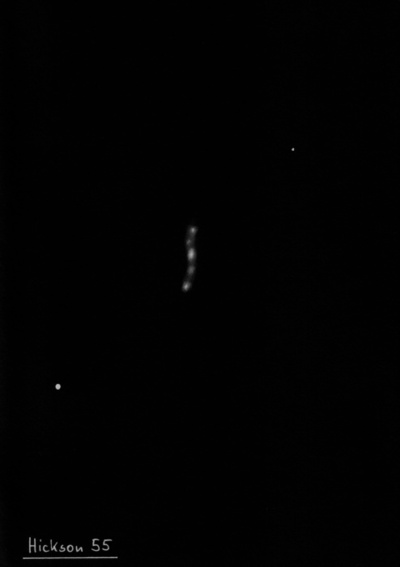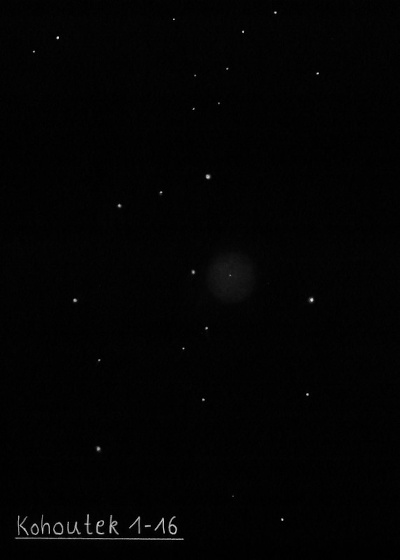A large, but not the brightest constellation in the North Pole region, which we can admire in our sky every clear night because it never sets. It is composed mostly of medium bright and fainter stars that form an almost semicircle around Polaris. The head of Draco is made up of the stars γ (Etamine), β (Alwaid), ξ and ν Draconis and is a rather striking star pattern, from which the bright Vega from the constellation Lyra shines not far away. The body is spread between two celestial bears. The brightest star, Thuban, Polaris at the time of the building of the pyramids, lies at the centre of the conjunction of the stars Kochab of the Little Bear and Mizar of the Big Bear. The dragon is the eighth largest constellation, and despite lying further away from the Milky Way, it hides many deepsky objects. They are mostly faint galaxies, many of interesting appearance, but there are also some nice binaries that can be resolved with a binocular or small telescope. In Draco, we also find the extremely bright planetary nebula NGC 6543, known as the Cat's Eye. Not far from it lies the north pole of the ecliptic.
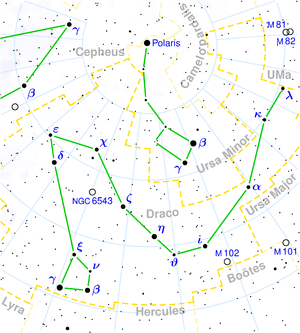
Etamin (γ Dra) - The brightest star of the constellation reaches a magnitude of 2 and is clearly orange. It is located 154 light-years away from Earth and is 471 times brighter than the Sun. In the past, it was observed by the English astronomer James Bradley, who used it to discover the aberration of light.
Rastaban (β Dra) - The star has a brightness of 2.8 magnitude and is located 380 light-years away. Together with Etamin, it forms the "Dragon's Eyes". Beta Draconis is a binary star consisting of a main yellow component and a faint companion of 14 magnitude at an angular distance of 4.2", which is not easy to see.
Thuban (α Dra) - Once the brightest star in the constellation, it now has a magnitude of only 3.6. 4,800 years ago, during the time of ancient Egypt, it marked the northern celestial pole and was only 10 arc minutes away from it. However, due to the precession of the Earth's axis, the pole has since shifted towards Polaris, and Thuban is now over 25 degrees away from it. Thuban belongs to the spectral class AO and is located between Mizara and Kochab. It is 215 light-years away and is 135 times brighter than the Sun.
Kuma (ν Dra) - A wide double star composed of two nearly equally bright white stars (4.9 mag), which are located at a mutual separation of 61.9". Even when observing this pair in a telescope, a splendid view is offered. Both components are located 99 light-years away from us.
39 Dra - A multiple star that is visible as a wide pair of stars with magnitudes 5 and 8, even with a small telescope or a binocular. Examining the brighter star at high magnification will reveal an additional (and much closer) component, which also has a magnitude of 8.
16/17 Dra - A nice wide double star, distinguishable in binoculars or small telescopes. The brightness of both components is almost 5.5 magnitude, and they are separated by 90.3". In reality, the component 17 Dra has a close companion, which is located at a distance of 3.4". All stars are bright white.
Alrakis (μ Dra) - A well-known binary star, whose both white components have a brightness of about 5.65 mag, but appear as a single point of 5th magnitude to the naked eye. The mutual orbital period of both companions is over 812 years. By the end of the 20th century, the two stars were separated by about 1.9", requiring higher magnification to be resolved. Therefore, it is a suitable test for a good 100 mm telescope. The system is located 89 light-years away from Earth.
RY Dra - a variable star with a deep red hue. It is one of the cool carbon stars, notable for the carbon molecules present in its atmosphere. The brightness of the star varies between 9.4mag and 11.4mag over a period of 172 days. In a larger telescope it is always found in the middle of the southeastern side of the isosceles triangle of stars 7, 8 and 9 Draconis.
RY Dra - a variable star with a deep red hue. It is one of the cool carbon stars, notable for the carbon molecules present in its atmosphere. The brightness of the star varies between 9.4mag and 11.4mag over a period of 172 days. In a larger telescope it is always found in the middle of the southeastern side of the isosceles triangle of stars 7, 8 and 9 Draconis.
RY Dra - a variable star with a deep red hue. It is one of the cool carbon stars, notable for the carbon molecules present in its atmosphere. The brightness of the star varies between 9.4mag and 11.4mag over a period of 172 days. In a larger telescope it is always found in the middle of the southeastern side of the isosceles triangle of stars 7, 8 and 9 Draconis.
RY Dra - a variable star with a deep red hue. It is one of the cool carbon stars, notable for the carbon molecules present in its atmosphere. The brightness of the star varies between 9.4mag and 11.4mag over a period of 172 days. In a larger telescope it is always found in the middle of the southeastern side of the isosceles triangle of stars 7, 8 and 9 Draconis.
Wolf 457 - White dwarf, one of the smallest known stars - its diameter is only 380 km. It is located 48.9 light-years away and from Earth, we see it as a 13mag object.
NGC 6543
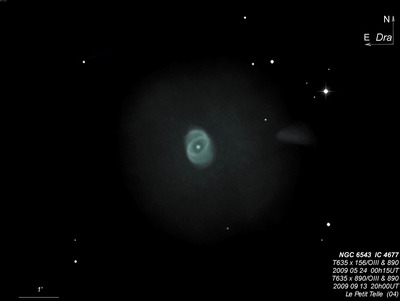
William Herschel discovered NGC 6543 = H IV-37 on 15 Feb 1786 (sweep 523) and recorded "vB, about 35" diameter. A planetary disk, but very ill defined edge; the center of it is rather more luminous than the rest. With long attention a very bright, well defined, round center becomes visible. This seems to be a nebula that connects my former planetary ones with two other sorts; viz with those that are very bright in the middle and suddenly grow more diluted; and with those that have a bright central star, or nucleus and a milky chevelure."
In 1790, Lalande included this object as a 9th magnitude "star" (LL 38303 in his major star catalogue. Giuseppe Bianchi independently rediscovered it on 16 Jun 1839 and announced the discovery an Astronomische Nachrichten letter, apparently unaware of WH's prior discovery (there were many similar cases). Surprisingly, NGC 6543 does not appear in John Herschel's Slough catalogue, which was more accessible and easier to check than WH's catalogues.
Sir William Huggins examined NGC 6543 with a spectroscope on 29 Aug 1864 (the same night he viewed NGC 6572, 6828, 6818, 7009, 6720, 7662, 6853). He wrote "On the evening of the 29th of August, 1864, I directed the telescope for the first time to a planetary nebula in Draco [NGC 6543]. The reader may now be able to picture to himself to some extent the feeling of excited suspense, mingled with a degree of awe, with which, after a few moments of hesitation, I put my eye to the spectroscope. Was I not about to look into a secret place of creation? I looked into the spectroscope. No spectrum such as I expected ! A single bright line only!" At first, I suspected some displacement of the prism, and that I was looking at a reflection of the illuminated slit from one of its faces. This thought was scarcely more than momentary; then the true interpretation flashed upon me. The light of the nebula was monochromatic, and so, unlike any other light I had as yet subjected to prismatic examination, could not be extended out to form a complete spectrum." Based on subsequent observations, Huggins showed nebulae had bright [OIII] emission lines, unlike the broad spectrum expected of unresolved stars. He concluded these objects were enormous masses of hot luminous gas or vapour which would never be resolved into stars.
The 1888 paper "Observations of Nebulae at the Lick Observatory" (1888MNRAS..48..388H) included a schematic labeled "Helical Nebula in Draco (Holden)" showing two overlapping ellipses or coils, along with a detailed sketch and description of the nebula. Heber Curtis wrote "We have, therefore, ventured to designate this object as a helical nebula - the first of its class - because its brighter portions unquestionably appear to the eye in a helical and not simply in a spiral form; and also because it seems to us at least probable that the real disposition of the brighter parts in space may be in the form of a helix." Generally, the nickname "Cat's Eye Nebula" is used today.
E.E. Barnard discovered IC 4677, a shock-excited knot in the outer halo of NGC 6543, on 24 Apr 1900 with the 40-inch Yerkes refractor. See Harold Corwin's notes.
200/250mm - 8" (7/27/84): bright, elongated, blue, high surface brightness.
300/350mm - 13.1" (7/27/84): at 400x appears very bright, oval N-S, blue color, central star visible with averted.
400/500mm - 17.5" (6/11/88): viewed at 280x and 412x; the Cat's Eye nebula appears very bright, fairly small, oval SW-NE, blue-green color. Appears darker (annular) surrounding the mag 11 central star. The prominent visual portion is surrounded by a very faint oval outer envelope (386") which was not seen but includes the bright irregular knot IC 4677 1.7' W of center. NGC 6552 is located 10' following. IC 4677 was suspected at 220x without filtration close to a mag 15 star located 1' W of the planetary. Using a UHC filter, IC 4677 was clearly visible with averted vision as a very faint elongated patch, ~25"x15" oriented SW-NE. Requires averted for a good view but could hold steadily almost continuously. It was also visible at 140x with an OIII filter and 280x with the UHC, but 220x provided the best view.
900/1200mm - 48" (4/1/11): the extremely bright inner section [22"x19"] of the Cat's Eye was a vivid green color at 375x. But besides the bright central star I didn't take notes on the interior structure. A fairly faint (middle) halo was easily visible, extending ~1.4' diameter and dramatically increased the generally observed size. This halo had a well-defined periphery and was slightly elongated N-S or the border on the east and west sides were very slightly flattened. A very faint star is near the west edge.
Surrounding the middle shell is a much larger and fainter outer halo that extends ~5' in diameter. IC 4677 appeared as a prominent, triangular or wedge-shaped knot with the vertex pointing east, situated 1.8' due west of center near the edge of this outer halo. It appeared much larger than previously seen, ~50"x30", and brighter along a well-defined, straight southern edge. The north side is brightest near the east end at the vertex. A 15th magnitude star lies 45" NE and a mag 9.8 star is 1.2' NW. A second fainter knot in the outer halo is located 2.6' ESE of center, just 30" N of a mag 14.5 star. This knot was only 15"-20" in size and had a low surface brightness.
Notes by Steve Gottlieb
NGC 5907
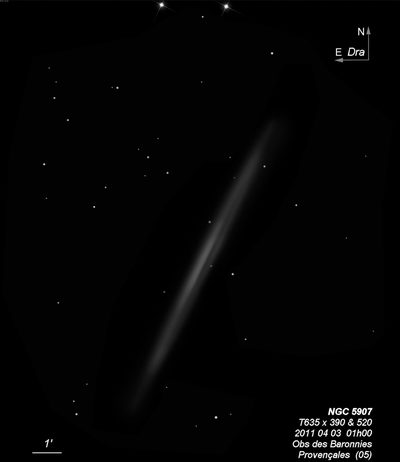
William Herschel discovered NGC 5907 = H II-759 = h1917 on 5 May 1788 (sweep 842) and recorded "pB; 8 or 10' long, 1.5' or 2' broad, FNM." On sweep 347, JH logged "B; a superb ray nebula, at least 7.5' long and narrow, pos = 159.9° by meas; at first vgb, then psmbM."
George Stoney was the first to note the dust lane on 13 Apr 1850 at Birr Castle. He described a "very remarkable ray, 12' or 15' long; alpha, beta, gamma and delta are stars, of which alpha is faint; a longitudinal split precedes the nucleus." A faint star was sketched within the portion to the west of the dust lane. The dust lane was confirmed on 13 Apr 1855. On 23 Apr 1860, Samuel Hunter described "south-preceding nucleus there is a dark space with vF neby beyond, & south-following nucleus is rather dark with a portion much brighter beyond, then another dark space and again neby." The faint portion of the galaxy preceding the dust lane was catalogued as GC 4086 = NGC 5906.
200/250mm - 8" (6/5/81): impressive, needle-like streak.
300/350mm - 13" (6/18/85): very large, very elongated, narrow streak, bright core, faint star is west of the core.
400/500mm - 17.5" (6/6/86): fairly bright, extremely large edge-on 9:1 NNW-SSE, extends to roughly 13'x1.5'. Contains a bright core increasing to a near stellar nucleus. A mag 14 star lies 1.1' W of center.
600/800mm - 24" (7/8/13): this showpiece edge-on contains a very bright, large, thin extended core but no well defined nucleus. The galaxy nearly fills the 15' field at 280x, extending ~12'x1', with a patchy surface brightness towards the tips. A thin dust lane on the preceding side of the core can be traced at least 5'. A thin, low surface brightness strip (catalogued as NGC 5906) is visible on the west side of the dust lane.
900/1200mm - 48" (4/21/17): at 375x; huge showpiece splinter extending 10' to 12' NW-SE and ~0.8' wide. The central 2' long core region is very bright and contains a slightly brighter nucleus. The outer extensions have a lower, irregular surface brightness and appear patchy. A sharply defined dust lane slices through the central region, creating two asymmetric sections with the thin, brighter core section on the eastern side. An easily visible glow is on the western side of the dust lane (catalogued separatedly as NGC 5906), though it has a much lower surface brightness. A mag 14 star is 1' W of the core. Overall, the view was very comparable to the DSS2 image.
Notes by Steve Gottlieb
M 102
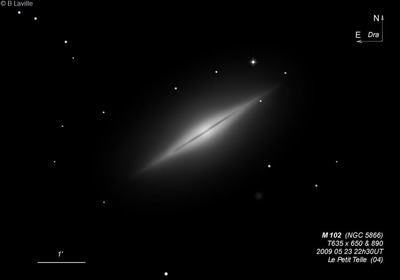
William Herschel discovered NGC 5866 = H I-215 = h1909 on 5 May 1788 (sweep 842) and recorded "vB, cL, E, following 2 stars." His position is poor - nearly 6' southwest of the galaxy. NGC 5866 is likely an edge-on S0 galaxy with a dust lane. NGC 5866 was first observed by Lord Rosse on 27 Apr 1848 and described as "A very bright resolvable nebula, but none of the component stars seen distinctly even with a power of a thousand. A perfectly straight and longitudinal division in the direction of the major axis." George Johnstone Stoney's (Lord Rosse's assistant) sketched the galaxy and dust lane on 27 Apr 1849 (plate XXXVII, figure 8, 1850 publication).
This galaxy is sometimes taken as M102 for completeness of the Messier catalogue. Pierre Méchain found M102 on 27 Mar 1781, but in a letter dated 6 May 1783 to Johann Bernoulli, the editor of the Berliner Astronomisches Jahrbuch, he stated M101 and 102 "are nothing but the same nebula, which has been taken for two, by an error in the charts." But in the September 2015 issue of Sky & Tel, Michael Covington argues that Mechain probably did see NGC 5866, along with the adjacent 7th-magnitude star and Messier may have confirmed the observation. See Harold Corwin's notes for a more detailed analysis of M102.
200/250mm - 8" (6/4/83): fairly bright, brighter central bulge, fainter extension.
300/350mm - 13" (6/4/83): very bright, impressive, large bright core, two stars off the NW and SW edges. A mag 7 star is 10' SW.
400/500mm - 17.5" (6/6/86): very bright, fairly large, elongated 2:1 NW-SE, 3.0'x1.5', bulging bright core. This galaxy has a high surface brightness and a mottled surface. Just a hint of the razor-thin dust lane prominent on photographs is visible. A mag 11.5 star is at the NW end 1.6' from the center and a slightly fainter mag 12 star is 1.5' SW. Located 10' NE of mag 7.5 SAO 29401.
600/800mm - 24" (7/6/13): at 200x appeared extremely bright, large, very elongated 3:1 NW-SE, spindle shaped, well concentrated with a blazing oval core. A very thin, low contrast dust lane bisects the galaxy and is most evident along the central bulging core. The outer halo is much fainter and extends ~3.25'x1.25'. A mag 11.3 star is just off the NW flank, 1.6' from center and a mag 12.2 star is off the SW side 1.4' from center. At 322x, NGC 5867 was picked up 1.0' SSE of the mag 12.2 star as a very faint 8" glow, held continuously with averted vision. NGC 5866B, situated 47' E, appeared faint, ~1' in diameter, slightly elongated N-S, very low surface brightness. Seems to have a small slightly brighter central region.
900/1200mm - 48" (4/21/17): at 488x and 697x; spectacular lenticular (S0/a) with a razor-thin dust lane perfectly bisecting the galaxy. Overall the galaxy is extremely bright, very elongated 3:1 NW-SE, roughly 4'x1.35'. The main spindle contains an intensely bright, bulging oval core that is nearly perfectly bisected by an extremely narrow dust lane. The outer portion of the halo has a low surface brightness and increases in size with averted vision. A mag 11.3 star is at the northwest edge of the halo and a mag 12.2 star is just off the southwest side, 1.4' from center. Also a mag 15.5 star is superimposed on the northwest halo [1.6' from center]. NGC 5867, one of the faintest in the NGC, lies 2' SE. SDSS J150631.55+554348.9, an 18th magnitude galaxy, was marginally glimpsed 2.0' SSE of center.
Notes by Steve Gottlieb
NGC 4236
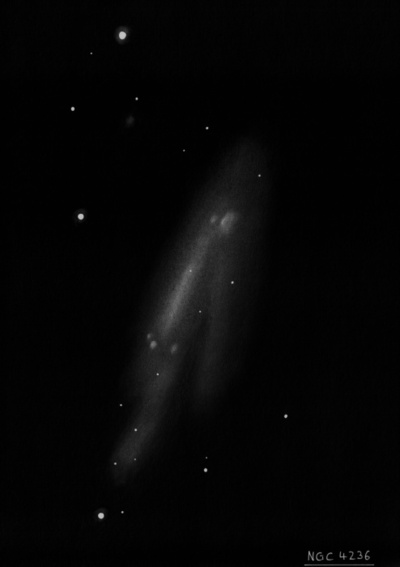
William Herschel discovered NGC 4236 = H V-51 = h1163 on 6 Apr 1793 (sweep 1036) and recorded "vF, mE, lbM, about 25' long, and losing itself imperceptibly, about 6 or 7' broad, from about 70° np to sf." His position, measured again on the next sweep, is accurate. John Herschel reported, "immensely large; vF; mE; vgbM; it fills more than a field, but is hardly distinguishable. Hazy." He incorrectly labeled his h1163 as H. V-17 in the Slough Catalogue.
300/350mm - 13.1" (5/27/84): faint, very large, very elongated NNW-SSE, weak concentration. In a field with five mag 8-9 stars.
400/500mm - 17.5" (3/29/89): faint, extremely large, edge-on 5:1 NNW-SSE. Appears as a ghostly streak about 20' length with only a broad, weak concentration! Best at low power due to size and low surface brightness.
Notes by Steve Gottlieb
NGC 4319
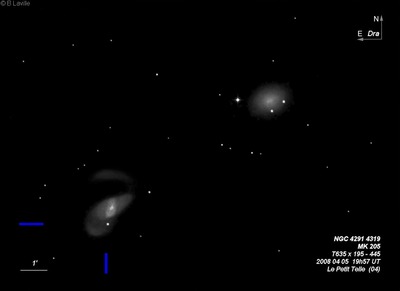
300/350mm - 13.1" (2/23/85): fairly faint, small, bright core, stellar nucleus. The quasar Markarian 205 (controversial quasar with an apparent discordant redshift) appears as a faint mag 14.5 stellar object 0.7' south of center. Forms a pair with NGC 4291 6' NW.
Notes by Steve Gottlieb
NGC 6742
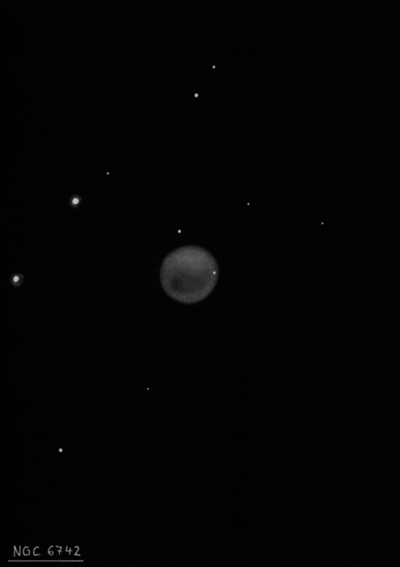
William Herschel discovered NGC 6742 = H III-742 on 8 Jul 1788 (only object in sweep 849) and noted "vF, stellar, 300 verified it." He included this planetary in class III of "Very Faint Nebulae". d'Arrest's single position is accurate to within 1'.
400/500mm - 17.5" (7/22/01): moderately bright, fairly small, perfectly circular. Easily picked by scanning region at 100x just 3.5' NE of mag 8.9 SAO 47978. Appears unevenly lit at 280x, ~30" diameter with slightly enhanced regions along the rim. A very faint star is off the NE edge.
17.5" (5/10/86): at 220x without filter appears fairly faint, round, fairly small. At 105x using an OIII filter the planetary is bright and compact with crisp round edges.
600/800mm - 24" (10/4/13): picked up unfiltered at 200x but an excellent contrast gain adding an OIII filter. Appeared fairly bright, round, 30"-35" diameter, slightly unevenly lit. At 280x and 375x unfiltered, an extremely faint star (mag 16?) is barely inside the west edge and a mag 15 star is just off the NNE edge. Adding an NPB filter the rim appear to be slightly brighter, particularly along the north side.
Notes by Steve Gottlieb
NGC 5777
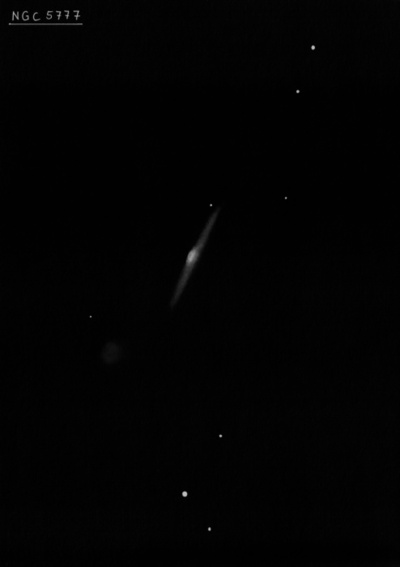
William Herschel discovered NGC 5777 = H III-806 on 17 Apr 1789 (sweep 924) and logged "vF, vS, lE." His position matches UGC 9568.
400/500mm - 17.5" (6/21/93): fairly faint, edge-on 5:1 NW-SE, 2.0'x0.4', small bright core, thin extensions. A mag 14.5 star is close to the NW tip, 1.2' from center. Located 20' S of mag 5.5 HD 131507.
600/800mm - 24" (7/6/13): at 200x appeared fairly bright, large, edge-on ~8:1 NW-SE, ~2.4'x0.3'. Contains a small bright core that is elongated and increases to a brighter sub-stellar nucleus. A mag 14.5 star is adjacent to the NW tip of the galaxy on the following edge. Forms a pair with UGC 9570, a dwarf galaxy 2.8' SE of center. The ghostly companion appeared as a very low surface brightness ill-defined glow, ~25" diameter.
900/1200mm - 48" (5/1/19): at 375x; bright, large, very thin edge-on NW-SE, 3.0'x0.3'. Sharply concentrated with a very bright, small but slightly elongated core. The galaxy extends just beyond a mag 14.5 star near the NW end. UGC 9570, a low surface brightness companion 2.7' SE of center, appeared fairly faint, moderately large, roundish, diffuse glow, ~40" diameter, very weak concentration.
Mrk 830, a distant Sy1 galaxy (light-travel time = 2.56 billion years) located 20' SSE, was easily visible and displayed a faint stellar nucleus surrounded by a very small halo, ~6" diameter.
Notes by Steve Gottlieb
NGC 4125
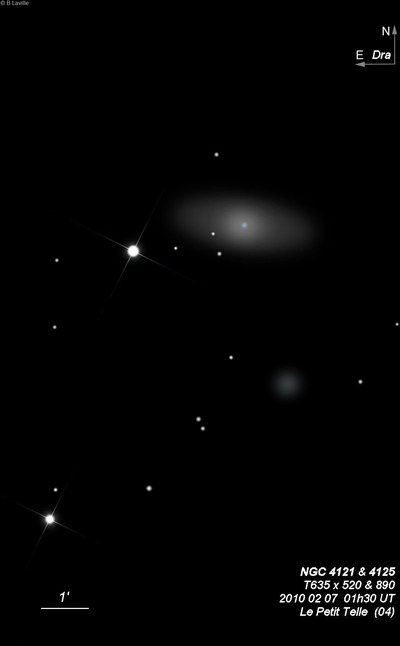
John Russell Hind discovered NGC 4125 = Au 28 on 5 Jan 1850 with a 7-inch Dolland refractor at George Bishop's private observatory in London. He noted "tolerably bright, but small." This was the second deep sky object he discovered after NGC 6760. In the next issue of Astronomische Nachrichten he added "of an elliptical form with a strong nuclear condensation." Hind's Crimson star is mentioned in the same note! Auwer listed this galaxy as #28 in his 1862 list of new nebulae.
400/500mm - 17.5" (3/20/93): bright, moderately large, very elongated almost 4:1 E-W, 2.5'x0.7'. A very bright elongated core and nearly stellar nucleus dominates the galaxy with much fainter extensions but overall the surface brightness is high. A mag 10 star is 2.4' ESE of center. Forms a pair with NGC 4121 3.6' SW.
Notes by Steve Gottlieb
NGC 6503
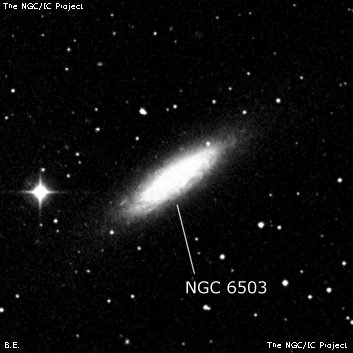
Arthur von Auwers discovered NGC 6503 = Au 37 on 22 Jul 1854 with his 2.6" Fraunhofer refractor while a 15-year old student at Gottingen University. He showed the new nebula to his friend Friedrich Winnecke, who was also a student there at the time. Winnecke, using a 9.6-inch Fraunhofer refractor in 1856 in Berlin, described "..a beautiful object; very bright, slightly brighter in the middle and extraordinarily extended from north preceding to south following, 3-4' long, 50" wide." Auwers observed NGC 6503 again on 19 Feb 1862 with the Konigsberg heliometer and wrote "bright 3'-4' long, at most 1' wide; gradually brighter in the middle. There appears to be a faint star in the northern part, which makes the nebula nearly look like a double nebula." Auwers' description was published in his 1862 list of 50 new nebulae.
William Herschel missed NGC 6503, mainly because of the high northern declination which he only searched in his later sweeps, though he did discover NGC 6434, which is about 3° from NGC 6503.
200/250mm - 8" (6/27/81): moderately bright, very elongated, high surface brightness. A mag 9 star is 4' E.
400/500mm - 17.5" (6/11/88): very bright, large, very elongated 3:1 NW-SE, large brighter core. The surface has a mottled appearance. A mag 13.5 star lies 2.2' NNE of center. Located 3.9' W of mag 9 SAO 8937.
Notes by Steve Gottlieb
NGC 3147
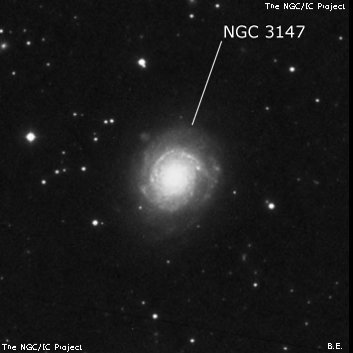
William Herschel discovered NGC 3147 = H I-79 = h674 on 3 Apr 1785 (sweep 390) and noted "cB, pL, R, mbM. The brightness decreasing very gradually." John Herschel reported on 4 Nov 1831 (sweep 382), "vB; L; R; at first vg, then vs, vsbM."
400/500mm - 17.5" (2/8/91): bright, fairly large, slightly elongated 4:3 NW-SE. Contains a very bright core with a stellar nucleus. There is an impression of a dust lane to the west of the core.
Notes by Steve Gottlieb
NGC 4589
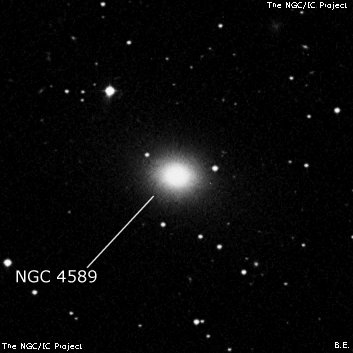
William Herschel discovered NGC 4589 = H I-273 = h1374 on 22 Nov 1797 (sweep 1064) and logged "vB, R, mbM, 3 or 4' dia." His position is 4.5' southeast of UGC 7797. JH made 4 observations, recording on sweep 348 "B; R; pgmbM; 30"; a S * np; dist 1'." His position on this sweep was very accurate.
400/500mm - 18" (5/8/04): bright, fairly large, elongated ~4:3 E-W, 2.5'x2.0'. Sharply concentrated with a very bright prominent core and a fainter halo. A mag 13 star is at the west edge of the core. Forms a pair with NGC 4572 7.5' NW and NGC 4648 lies 22' NE. A wide mag 8/10.5 double at 24" lies 17' NE (in the field with NGC 4648).
Notes by Steve Gottlieb
UGC 10822
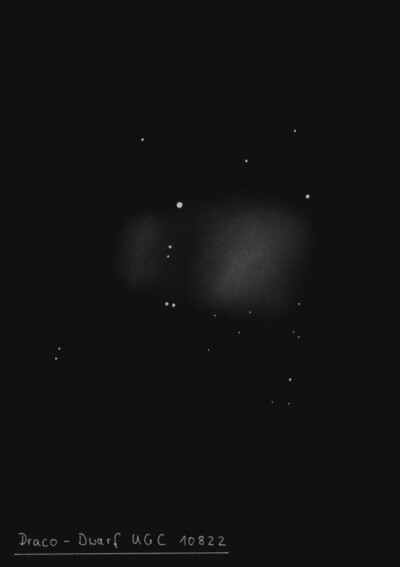
400/500mm - 17.5" (7/14/99): in excellent transparency, the Draco Dwarf appeared as a very low surface brightness glow at 100x, roughly 15'x10', elongated N-S. On the eastern side are a couple of mag 11 pairs and the glow extends just beyond a N-S string of stars on the west side. There appeared to be a locally brighter region (possibly the core) offset towards the south side of the glow. The edges of the halo as the periphery generally faded into the background, though some areas seemed to have a more well-defined edge. Local Group member.
600/800mm - 24" (8/15/12): The 10' central region was visible as a patchy, irregular, low surface brightness glow. On the east side are two wide pairs (oriented E-W and N-S) at 20" and 24" separations and mag 8.8 HD 238677 is on the northeast side of the glow. PGC 140771, a very faint galaxy, lies 7' WSW of center, just beyond the central region. A half-dozen stars in an 8' string extends south from PGC 140771.
Notes by Steve Gottlieb
NGC 5982
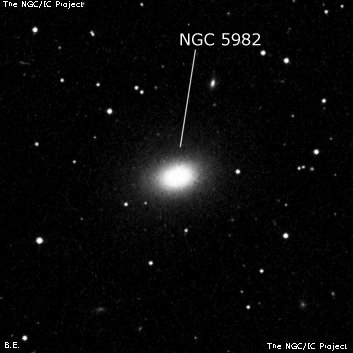
William Herschel discovered NGC 5982 = H II-764 = h1934 on 25 May 1788 (sweep 843) and noted "pB, S, iR. A vF [nebula] suspected preceding, lE." Herschel's position is just off the southwest side. John Herschel noted "B; R; psbM; r; 25"." His position is midway between NGC 5982 and 5985 and only a single object was logged, so perhaps the observation was rushed or interrupted.
On 6 May 1850, Lord Rosse's observing assistant George Johnstone Stoney logged "B, condensed oval neb."
300/350mm - 13.1" (5/14/83): fairly bright, small, small bright nucleus, slightly elongated E-W. In a trio with NGC 5981 and NGC 5985.
400/500mm - 17.5" (3/28/87): fairly bright, fairly small, bright round core, stellar nucleus, fainter halo elongated 3:2 ~E-W. Second of a striking trio with NGC 5981 6.4' WNW and NGC 5985 7.5' ESE.
600/800mm - 24" (5/29/14): bright, moderately large, elongated 5:4 WNW-ESE, sharply concentrated with a high surface brightness intense core that increases to a stellar nucleus. The halo extends up to 1.6'x1.3'. Second in the Draco triplet with edge-on NGC 5981 6.3' WNW and spiral NGC 5985 7.5' ESE.
Notes by Steve Gottlieb
NGC 4291
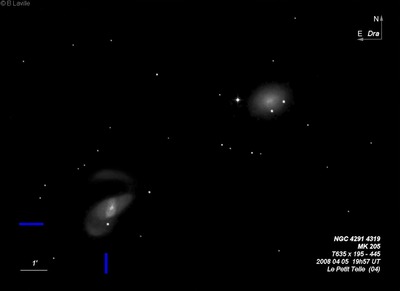
William Herschel discovered NGC 4291 = H I-275 = h1192, along with NGC 4319, on 10 Dec 1797 (sweep 1066) and noted "cB, S, R." JH made four observations and logged on sweep 349 "pF; R; gbM; 20"; followed and almost surrounded by 3 stars 10m, one of which is double; has also a vS * sp dist 30"."
300/350mm - 13.1" (2/23/85): fairly bright, small, round, small bright nucleus, possible stellar nucleus at 312x. A mag 14 star is at the west edge 25" from the center. Form a pair with NGC 4319 6' SE. Located 13' NNE of mag 5.4 SAO 7540. NGC 4386 lies 20' NE.
Notes by Steve Gottlieb
NGC 5985
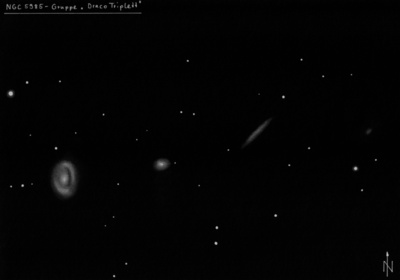
William Herschel discovered NGC 5985 = H II-766 on 25 May 1788 (sweep 843) and noted "pB, cL, iF, r." He measured an accurate position (CH's reduction) and discovered NGC 5982 (NGC 5981 as only noted as suspected).
George Johnstone Stoney, Lord Rosse's observing assistant, recorded "Suspect A to be a spiral, to be re-examined on a fine night." (6 May 1850). A week later (14 May) he wrote "Examined A; new spiral? Dark space round or on either side of Nucl seen at moments, also a dark line running along the south-following edge, splitting off a part of the neb, which had a bright knot to south, also some ill defined dark space at N end."
300/350mm - 13.1" (5/14/83): moderately bright, moderately large, diffuse halo N-S. Brightest of trio.
400/500mm - 17.5" (3/28/87): fairly bright, large, small bright core, mottled oval disc ~N-S. There is possibly a sharper light cut-off along the western side. Third and brightest of three with NGC 5982 7.5' WNW and NGC 5981 13.8' WNW.
600/800mm - 24" (7/6/13): bright, very large, oval 2:1 ~N-S, ~4'x2', broad concentration with a bright 40"x30" core. Spiral structure is evident in the uneven halo, with at least two long sweeping arms giving the impression of a stretched "S" and slightly darker gaps between the arms.
Notes by Steve Gottlieb
NGC 6015
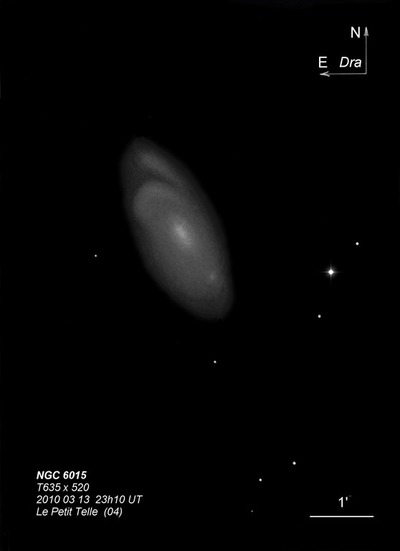
William Herschel discovered NGC 6015 = H III-739 on 2 Jun 1788 (sweep 844) and recorded "vF; R; about 3' diam; vgbM; easily resolvable." Dreyer also gives d'Arrest's summary description "B, mE" in the NGC as it differs so much from WH's. In the IC 1 Notes, Dreyer mentions that William Denning stated that d'Arrest's description was correct.
300/350mm - 13.1" (5/14/83): fairly faint, fairly large, elongated 2:1 SSW-NNE, 4.0'x1.8', diffuse, almost even surface brightness. Located 2.3' E of a mag 11 star. A mag 13.5 star is at the SSW end 1.9' from the center.
Notes by Steve Gottlieb
NGC 6643
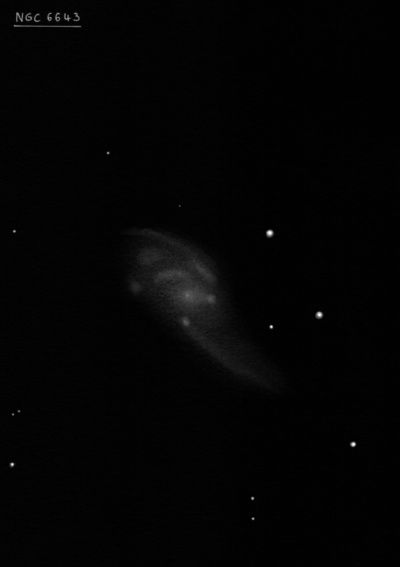
Eduard Schönfeld discovered NGC 6643 = Au 40 = HN 21 in 1858 while measuring stars for the Bonner Durchmusterung (BD +74 766). This relatively bright galaxy was missed by both Herschels. Horace Tuttle rediscovered the galaxy on 1 Sep 1859 using a 4-inch comet-seeker at Harvard College Observatory and called it "an elongated faint nebula" (reported in AN 1337). Using the 6-inch Heliometer at Königsberg, Auwers described the nebula as "fairly bright, gradually brighter in the middle, elongated in PA 50°, 2.5 'l, 1.5' br. Two small star are immediately preceding; the major axis of the nebula is inclined only slightly with respect to their connecting line."
Around the time of discovery there was discussion this was possibly a "variable nebula" (a popular topic in the mid to late 19th century), based on very disparate descriptions by Tuttle and d'Arrest (4 observations in "Siderum Nebulosorum"). Wolfgang Steinicke provides the observational history in his book on the NGC discoveries.
200/250mm - 8" (6/19/82): faint, diffuse, moderately large, elongated SW-NE. Two mag 12 stars are at the west edge.
400/500mm - 17.5" (7/9/88): fairly bright, large, oval 2:1 SW-NE, broadly concentrated halo. Forms the east vertex of a triangle with two mag 11.5 stars 1.6' NW and 2.0' W. Also a mag 15 star is off the west edge 1.4' from center.
Notes by Steve Gottlieb
NGC 5678
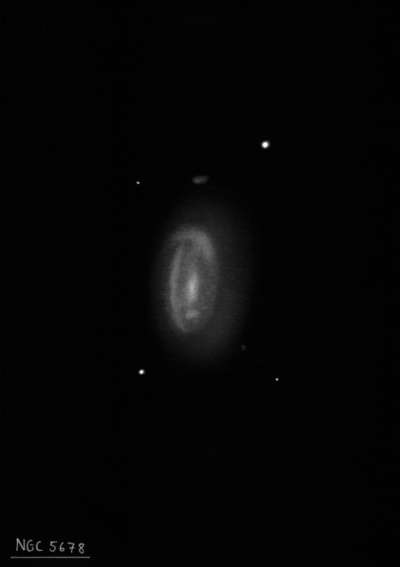
William Herschel discovered NGC 5678 = H I-237 = h1843 on 17 Apr 1789 (sweep 924) and logged "B, irregular oval, vgmbM." His position and description matches UGC 9358. JH made two observations, noting on sweep 345 "B; lE in merid; gmbM; 50"." Bindon Stoney, observing with LdR's 72" on 26 Apr 1851, logged "S, E ns, light mottled, vlbM, Nucl suspected, within a trapezium of 4 or 5 stars."
300/350mm - 13.1" (5/26/84): fairly bright, elongated 2:1 N-S, broad mild concentration. Located 2.6' SSE of mag 8.9 SAO 29187 (double star A 1106 = 9.7/10.9 at 2"). A mag 12.5 star lies 1.9' SE of center.
Notes by Steve Gottlieb
NGC 6140
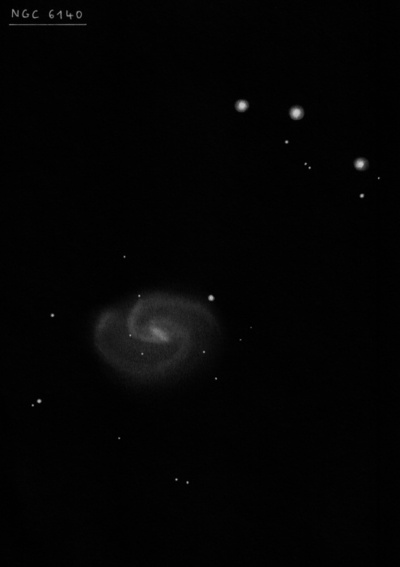
William Herschel discovered NGC 6140 = H III-740 on 3 Jun 1788 (only nebula in sweep 845) and logged "cF, pL, iE." There is nothing at his position but 95 sec of RA following is UGC 10359. Dreyer noted this error in his 1912 Scientific Papers.
400/500mm - 17.5" (7/9/88): moderately bright, moderately large, elongated ~E-W, broadly concentrated halo, very faint extensions. A mag 12 star lies 2.2' NW. Bracketed by three mag 15 stars 1.4' SE, 1.6' NNE and 1.9' SW of center.
600/800mm - 24" (7/22/14): fairly bright, moderately large, oval 3:2 WSW-ENE, broad concentration. Often a thin brighter "bar" oriented WSW-ENE stands out. It appears offset from center as the south portion of the halo is very weak. At 375x, a narrow spiral arm oriented E-W is occasionally visible just south of the bar, and it extends slightly further east than the brighter central region. A mag 11.5 star lies 2.3' NW and several mag 15 stars are nearby.
Notes by Steve Gottlieb
NGC 5905
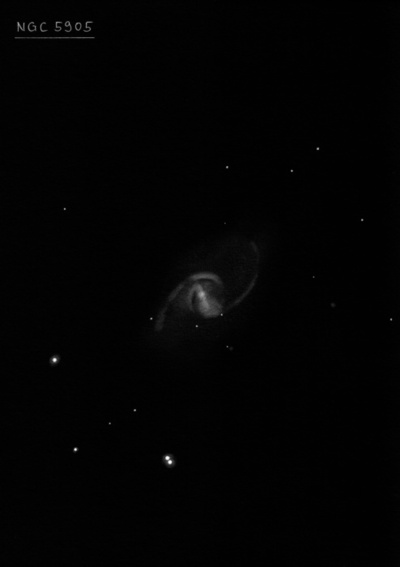
William Herschel discovered NGC 5905 = H II-758 on 5 May 1788 (sweep 842) and logged " pF, pS, iR." His position (offset from another galaxy) is 42 sec of RA too far west. NGC 5905 and 5908 were observed at Birr Castle on 13 Apr 1850 and assumed to be novae, so John Herschel assigned a separate General Catalog designation (4084). Dreyer combined the two GC designations in the NGC and reported an accurate position measured by d'Arrest.
300/350mm - 13" (6/4/83): fairly faint, moderately large, slightly elongated ~N-S, diffuse halo increases to brighter core.
400/500mm - 17.5" (5/23/87): moderately bright, moderately large, bright core, elongated 3:2 NW-SE. A mag 14 star lies 1.6' E of center. NGC 5908 lies 12' SE.
600/800mm - 24" (7/28/19): at 322x; fairly bright, moderately large, 1.5' diameter, slightly elongated, sharply concentrated with a very small bright nucleus. A slightly brighter "bar" runs SW-NE through the nucleus, but the contrast is low. The halo has a fairly low surface brightness and there was only a subtle hint of spiral arms. A mag 15 star is 0.7' SW of center (in halo), a mag 15.3 star is 0.8' S of center (in halo) and a mag 14.4 star is 1.6' E of center (outside halo). A mag 11/11.5 double star (WZ 13) at 9" separation, lies 4' SSE. Member of the NGC 5908 group (LGG 395).
MCG +09-25-037, located 12' WNW, appeared very faint, fairly small,roundish, ~25" diameter, very low surface brightness, requires averted vision.
Notes by Steve Gottlieb
NGC 5908
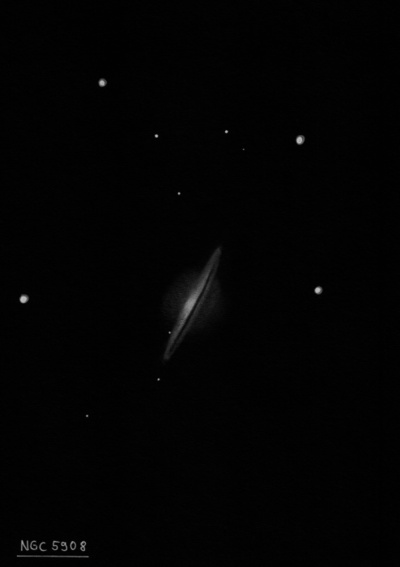
William Herschel discovered NGC 5908 = H II-760 on 5 May 1788 (sweep 842) and logged "pF, pS, R." His RA is 1.0 min too small, though his positions are systematically offset too far west on the sweep (poor position for the offset "galaxy").
300/350mm - 13" (6/4/83): fairly bright, fairly small, edge-on, brighter along major axis. Forms a pair with NGC 5905.
400/500mm - 17.5" (5/23/87): moderately bright, fairly small, very elongated 5:2 NNW-SSE, 2.5'x1', weak concentration. A mag 11 star lies 3.4' NW of center on a line parallel with the major axis. Forms an interesting pair with NGC 5905 12' NW.
Notes by Steve Gottlieb
NGC 6412
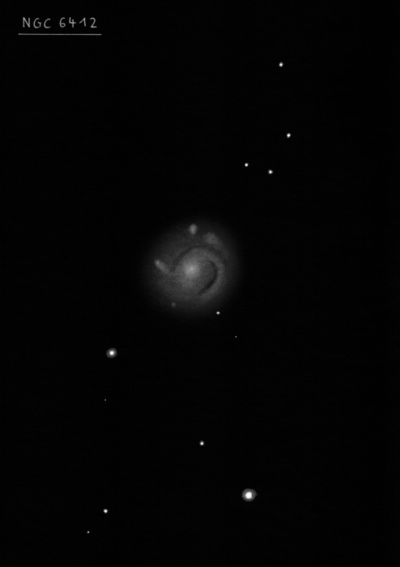
William Herschel discovered NGC 6412 = H VI-41 on 12 Dec 1797 (sweep 1071) and surprisingly described this galaxy as a cluster of class VI (very condensed and rich clusters of stars) -- "round, resolvable, about 3' diameter, vgbM. I suppose it to be a cluster of stars compressed extremely. 320 power confirms the supposition, and shews a few of the stars; it must be immensely rich." CH's reduced position is 30 tsec west (only 1.8' at this dec) of Arp 38 = UGC 10897. Bigourdan measured an accurate position on 24 Jul 1884.
200/250mm - 8" (8/5/83): very faint, small, diffuse. Located north of two mag 8 stars in field.
400/500mm - 17.5" (7/9/88): moderately bright, irregularly round, 2.0' diameter, diffuse halo, weak even concentration to a brighter core. A mag 13.5 star is at the SW edge 1.1' from center. A string of three equally spaced stars begins with a mag 11 star 2' SE and includes two bright stars; mag 8.3 SAO 8824 4.1' S and mag 9.3 SAO 8821 7.6' SSW.
900/1200mm - 48" (10/22/11): at 375x appeared bright, large, round, 2' diameter. Broad concentration with a large, brighter 30" core, hint of spiral structure in the halo though it was difficult to trace the arms. An HII knot or companion was easily seen superimposed at the edge of the halo on the north side (37" from center) and appeared faint, small, oval, ~12"x8". A mag 13.5 star lies 1' SW and a mag 16 star is 1.8' SW; both stars are collinear with the core. A bright mag 11.3 star lies 2' SE. Listed by Arp as a spiral with a "low surface brightness companion on arms", but the "companion" may be an HII region.
Notes by Steve Gottlieb
NGC 5963
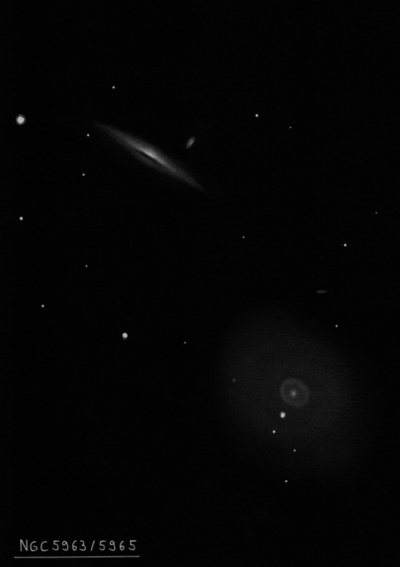
William Herschel discovered NGC 5963 = H II-761 on 5 May 1788 (sweep 842) and logged "pF, pS, iF." His RA is 38 sec too small (systematic offset on the sweep) and his dec 3' too small. The NGC position from d'Arrest is accurate.
400/500mm - 17.5" (5/22/93): fairly faint, fairly small, elongated 3:2 WSW-ENE, brighter core. Collinear with a mag 13 star 0.9' SSE and a mag 14 star 1.5' SSE of center. First in the NGC 5965 group with NGC 5965 8' NNE and NGC 5969 13' SE.
600/800mm - 24" (7/8/13): at 375x appeared fairly bright, fairly large, oval 4:3 SW-NE. Dominated by a large bright core with a much fainter halo that quickly dims to a very low surface brightness. Two mag 13/14.4 stars just off the southeast side are collinear with the core and a mag 15.8 star 2' NW is also on this line. First in the large KTG 63 trio with NGC 5965 9' NNE and NGC 5971 19' ESE. A couple of very faint galaxies are close; PGC 3848996, 2.2' E, was extremely faint (V = 16.2-16.3) and small, round, 8" diameter. PGC 214388, 3' NNW, appeared very faint (V = 15.9), very small, elongated 2: 1 ~E-W, 15"x8".
Notes by Steve Gottlieb
NGC 6211
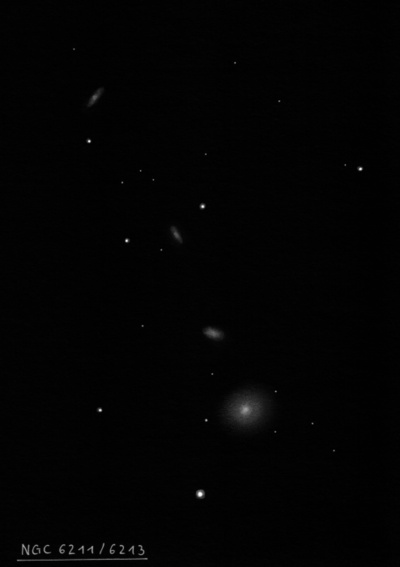
Lewis Swift discovered NGC 6211 = Sw. IX-63, along with NGC 6213, on 25 Jun 1887 and recorded "vF; pS; lE; D * nr south points to it." His position is 3' too far west-northwest, a similar offset as NGC 6213. Swift's original discovery was sent directly to Dreyer and noted as list VI in the NGC, but wasn't published until list IX in 1890. Bigourdan measured an accurate position on 27 Aug 1888 and Dreyer published the correct position in the IC 2 Notes.
400/500mm - 17.5" (6/18/88): fairly faint, small, round, bright compact core.
17.5" (6/20/87): moderately bright, moderately large, almost round, strong bright core, stellar nucleus. Brightest in chain of four with NGC 6213 2.2' NE.
Notes by Steve Gottlieb
NGC 6786
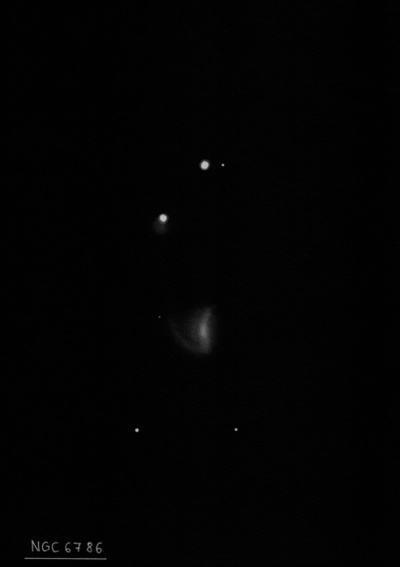
Lewis Swift discovered NGC 6786 = Sw. V-90 on 3 Oct 1886 and recorded "eeF; S; R; south-preceding of and near 2 stars." His position and description is an excellent match. Herbert Howe, observing with the 20-inch refractor in Denver in 1899-00, commented "the 2 stars north-following are of mag 10. The nearer one follows 11 seconds, 1.0' north. The more distant is very nearly north of the nebula, at a distance of about 2'. The NGC description is "eeF", but the nebula appears to be only "F"."
400/500mm - 17.5" (7/9/88): fairly faint, small, slightly elongated, small bright core. Two mag 12 stars are 1.8' N and 1.2' NE of center. The mag 12 star just 1.2' NE is superimposed directly on the center of UGC 11415, so the halo was not visible.
600/800mm - 24" (7/23/14): using 200x and 375x, appeared moderately bright and large, slightly elongated N-S, 0.6'x0.45', contains a small bright core. A mag 12.2 star is 1.8' N and a similar star is 1.2' NE.
NGC 6786 forms a close pair with UGC 11415, but the core of UGC 11415 is nearly hidden behind the glow of the mag 12 star close northeast. A very low surface brightness halo is just visible. With careful viewing, a small portion of the core is a bit more evident close northeast of the star.
Notes by Steve Gottlieb
IC 1291
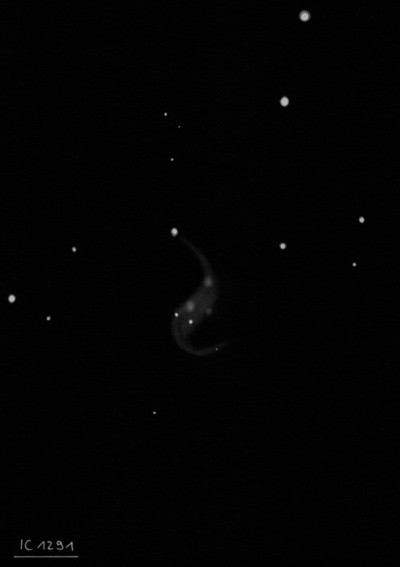
Lewis Swift discovered IC 1291 = Sw. X-46 on 5 Jun 1891 and recorded "eF; vS; R; F * close N." His position is 13 seconds of RA too far west and 2.3' too far north (3.3' NW of the galaxy). Herbert Howe, in his survey of NGC and IC objects around 1900, mentions he was unable to see a "F * close N", though noted two 12th mag star north-following and north-preceding. But Swift was probably referring to the star less than 1' NNE, which is closer to mag 13.5. Howe also measured an accurate position that was repeated in the IC 2 notes section.
400/500mm - 17.5" (7/24/95): very faint, small, irregular glow of 30" diameter. Appears to have no core but there are one or two extremely faint mag 15.5-16 stars superimposed on the south end. Nearly collinear with two mag 10.5-11 stars 2.3' and 3.3' NNW.
600/800mm - 24" (7/19/17): at 375x; fairly faint, moderately large, irregular shape. Two 15th magnitude stars are superimposed [separation 11" on DSS2] with a weak core just to the northwest of these stars. The glow elongates further to the NW of the core [this is the central bar]. An extremely small HII knot, ~5" diameter, occasionally popped in the same position near the NW end of the "bar" [18" NW of center]. There was a hint of an arm curling further northward towards a mag 13.5 star [0.8' NNE of center]. A mag 13 star is 1' WNW and two mag 11.5 stars further NW are collinear with the galaxy.
LEDA 214690 was glimpsed 3.7' NE. At 375x it appeared extremely faint (B ~16.7), very small, round, 12" diameter. It only occasionally popped with averted vision but verified as the position was consistent.
24" (9/10/15): at 260x; fairly faint, fairly small, elongated 2:1 NW-SE, increases in length with averted vision to ~40"x16". Appears to have a very faint quasi-stellar nucleus, along with a faint superimposed star very close southeast. A mag 13.5 star is less than 1' N of center. An HII region in the northwest spiral arm was not seen, though the transparency was fairly poor. Two mag 11-11.5 star lie 2.4' and 3.4' NNW (collinear with the galaxy) and a mag 9.8 star is 4.2' SW. Situated in a busy star field.
Notes by Steve Gottlieb
NGC 3212
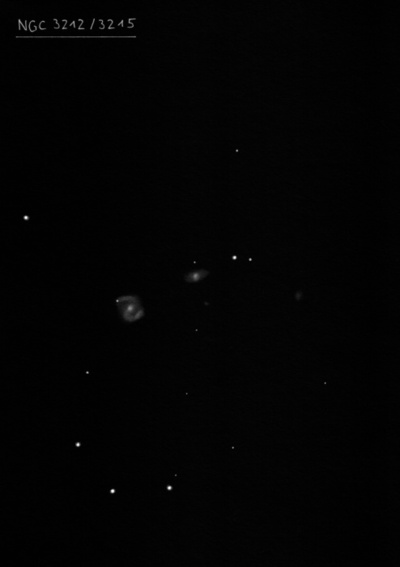
William Herschel discovered NGC 3212 = H III-980 on 26 Sep 1802 (sweep 1111, his second to last sweep) and recorded "Three, the place is that of the last [III-981]. The two last [NGC 3212 and 3215] vF and vS."
None of these 3 objects were included in WH's third catalogue as they were discovered just after his 500 discovery limit was reached on the previous object (NGC 3057). JH added III-980 as one of the 8 "HON" objects ("[William] Herschel omitted nebulae") in the Appendix to his Cape Observations. There are only two galaxies here that were measured accurately by d'Arrest and Bigourdan with III-979 = NGC 3210 a single or double star.
400/500mm - 17.5" (1/28/89): faint, very small, round. A pair of mag 13.5/14.5 stars at 24" separation is 1' WNW (= NGC 3210). Forms a pair with NGC 3215 1.2' SE.
Notes by Steve Gottlieb
NGC 6621
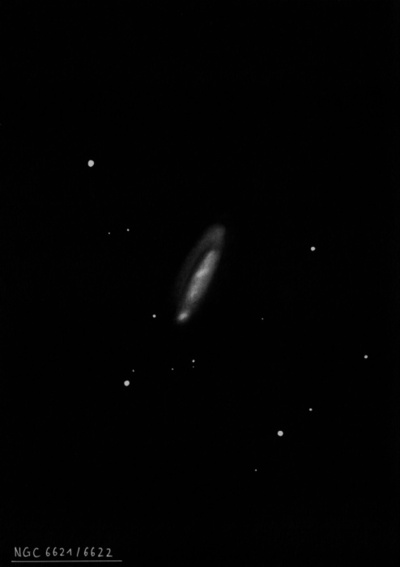
Edward Swift, the 14 year-old son of Lewis, discovered NGC 6621 = Sw. I-95 on 2 Jun 1885. The Swifts' position was 19 sec of RA too far east. This galaxy is the brighter of a very close double system, just 40" between centers. Apparently Lewis took another look in the eyepiece and discovered NGC 6622 = Sw. I-96. The note "n of 2" and "s of 2" were probably added after noticing it was double. Lewis Swift "discovered" this close pair again just two months later on 11 Aug 1885 and placed them in his second list (II-65 and II-66). He noted "forms a close double with the preceding. Very difficult to separate with power of 265. Well seen."
Dreyer combined the two observations in the NGC, though the published position is 14 seconds of time too large and 2' too far south. In addition, the RA is identical, though the orientation is northwest-southeast, and NGC 6622 is placed 0.2' north of NGC 6621. Bigourdan measured an accurate position for the pair on 28 Aug 1891 as well as Hermann Kobold in May 1899. When Herbert Howe measured the positions in 1899-00, he assigned NGC 6622 to the northwest galaxy and NGC 6621 to the southeast (agreeing with Swift's dec values), but modern catalogues reverse the identifications, placing the numbers in order of RA.
400/500mm - 17.5" (6/11/88): fairly faint, small, irregularly round, small bright core, stellar nucleus. Forms a double galaxy in a common envelope with NGC 6622 just 40" SE of center. A mag 15 star is 30" E.
900/1200mm - 48" (5/5/16): at 610x and 697x; NGC 6621/6622 is a spectacular interacting system (Arp 81 = VV 247) with an amazing tidal tail that wraps around both galaxies. NGC 6621 is sharply concentrated with a very bright, roundish core that increases to the center. The main halo or arms is elongated ~3:1 NW-SE, ~60"x20" with slightly brighter "handles" (ends of the spiral arms) on the NW and SE end. The enhancement on the NW side is more evident.
The southeast end merges with the halo of NGC 6622 with the cores of the galaxies separated by 40". A very small knot (at most 10" in size) was visible on a line between the two cores [16" NW of NGC 6622 and 26" SE of NGC 6621]. The HST image reveals this is a prominent blue starburst complex at the edge of the two galaxies.
On the northwest end, a broad tidal arm wraps sharply counterclockwise to the southeast (the arm is easily visible in this part), dims into a narrow tail and extends southeast, paralleling (about 30" to the east) the major axis of NGC 6621. This one-sided tail extends ~1.5' in length in the direction of a mag 15 star due east of NGC 6622 and ends in a slightly brighter knot, ~25" NE of NGC 6622.
48" (10/22/11): at 488x the main body of NGC 6621, which completely merges with NGC 6622, appears bright, fairly large, elongated nearly 3:1 NNW-SSE, ~1.1'x0.4'. Including NGC 6622 at the southeast end, the entire glow extends ~1.6'x0.4'. NGC 6621 is fairly sharply concentrated with a bright 20" core that gradually increases to the center. At 610x, a faint spiral arm is fairly evident attached at the NNW end and winding around counterclockwise to the north side of the main glow. On the HST image this is the beginning of a long tidal tail that wraps around the north side of both galaxies.
Notes by Steve Gottlieb
NGC 6090
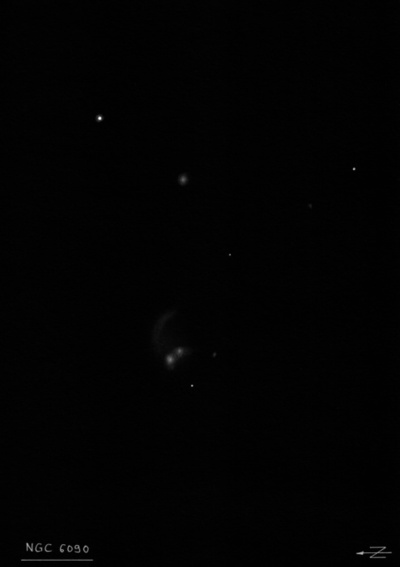
Lewis Swift discovered NGC 6090 = Sw. IX-56 on 24 Jun 1887 and recorded "vF; S; R." His position is 8 seconds west of UGC 10267, though he missed the two companions to the west. This galaxy, itself, is a merged, interacting system with tidal tails, etc. similar to the Antenna Galaxies.
400/500mm - 17.5" (6/15/91): faint, very small, elongated 4:3 SW-NE, even surface brightness. Forms a pair with CGCG 275-028 3' W. Also nearby is UGC 10261 6' W which was not recorded. This is a close double system, though was not resolved.
600/800mm - 24" (7/9/13): at 280x appeared moderately bright, fairly small, oval 4:3 SSW-NNE, 24"x18", high surface brightness. Inspection of the SDSS reveals a close double nucleus of a merged pair with very low surface brightness plumes extending SW and NE.
NGC 6090 is the last and brightest in a trio (WBL 610) with CGCG 275-28 3' W and UGC 10261 6' W. CGCG 275-28 was fairly faint, small, round, very small brighter nucleus, 15" diameter and UGC 10261 appeared fairly faint, moderately large, oval 4:3 NNW-SSE, 40"x30", weak concentration.
Notes by Steve Gottlieb
NGC 6636
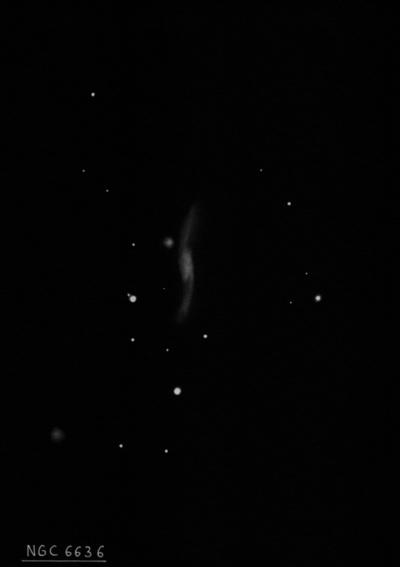
Lewis Swift discovered NGC 6636 = Sw. IV-68 on 23 Jul 1884 and recorded "eeeF; pS; R; forms triangle with 3 st." His position is at the west edge of UGC 11221 and the description fits. Herbert Howe, observing in 1899-00, reported "the 3 stars mentioned by Swift are of mags 9, 9.5 and 10.5. The one of mag 9.5 follows the nebula 4 seconds, 1.0' south. The others precede, and are also south."
400/500mm - 17.5" (6/11/88): fairly faint, fairly small, very elongated SSW-NNE, even surface brightness. The compact companion attached at the northeast side was not seen.
600/800mm - 24" (7/21/12): moderately bright, moderately large, very elongated 7:2 ~N-S, 1.1'x0.3', small slightly brighter core. Forms a contact pair with MCG +11-22-047 = PGC 61780, which is attached on the east side of the northern half. The companion was easily visible as a very small "knot", perhaps 10" diameter with a fairly bright stellar nucleus that sometimes dominated the small halo. The core of NGC 6636 (much lower surface brightness than PGC 61780) was close south-southwest of the companion. Two mag 11 stars are 1.2' SE and 2.1' S. An extremely faint, slightly non-stellar glow between these stars is a very close (~5") unresolved pair of mag 16.5-16.7 stars.
900/1200mm - 48" (5/5/16): fairly bright, fairly large, warped edge-on 6:1 ~N-S, 1.8'x0.3', bright elongated core. The southern half of the galaxy (including the core region) is slightly bowed out towards the west. The northern extension, though, is subtly convex to the east. So the opposite ends seem slightly misaligned and form a weak integral sign. Adding to the asymmetry, the outer half of northern extension has a much lower surface brightness than the southern arm. MCG +11-22-047 = PGC 61780 is a bright but very compact Seyfert II galaxy, ~10" diameter, just 20" NE of the core and attached to the east edge of the galaxy. It is dominated by a bright stellar nucleus with just a small halo. A mag 11 star is 2.1' due south and a mag 11.5 star (very unequal 6" pair) is 1' SE.
Notes by Steve Gottlieb
IC 1254
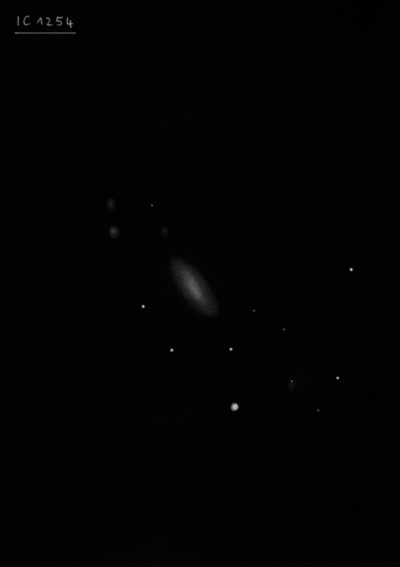
Edward Swift, Lewis' 19 year-old son, discovered IC 1254 on 18 Sep 1890 and recorded "eeeF; pS; R; nf of 2 [with IC 1251]; ee diff." The Swifts' position is 16 sec of RA east and 2' north of UGC 10769.
400/500mm - 17.5" (7/16/93): faint, fairly small, elongated 2:1 SW-NE, even surface brightness. Slightly fainter than IC 1251 6' W. Located 7' NE of NGC 6340.
17.5" (7/9/88): extremely faint, very small, slightly elongated, two mag 15 stars are 30" E and 1' SSE. Located 7' NE of NGC 6340 in a group. Probably only viewed the core.
Notes by Steve Gottlieb
NGC 4331
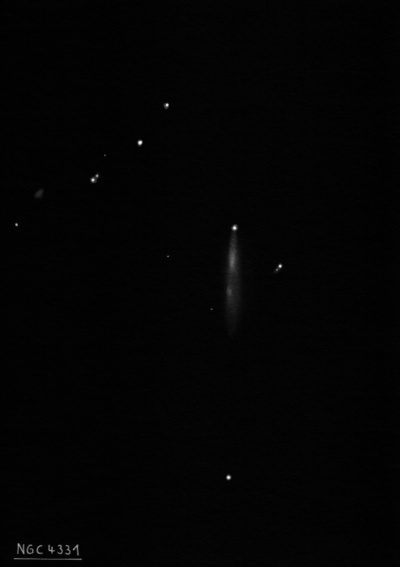
William Herschel discovered NGC 4331 = H III-942 = h1220 on 12 Dec 1797 (sweep 1068) and noted "eF, E near the meridian. Verified with 320x." CH's reduced position is 1.8' southeast of UGC 7449 and his description applies to this galaxy.
400/500mm - 18" (3/5/05): extremely faint, moderately large, edge-on 5:1 N-S. A mag 14-14.5 star is at the north tip and the galaxy appears as a ghostly dagger hanging to the south.
Notes by Steve Gottlieb
NGC 6365
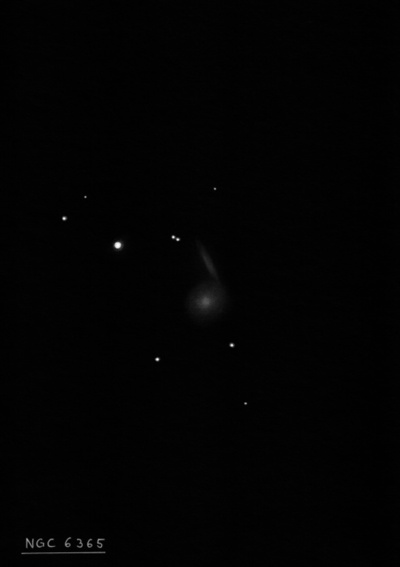
Lewis Swift discovered NGC 6365 = Sw. IV-49 on 15 Aug 1884 and recorded "eeeF; pL; iR; sev eF stars involved; B * nr south-following." There is nothing at his position, though 1.1 minutes of RA due east is Arp 30 = UGC 10832/10833 (double system). The bright star in his description is actually north-following. MCG fails to identify either MCG +10-25-018 or -019 as NGC 6365.
400/500mm - 17.5" (7/16/88): this is a double galaxy (Arp 30) with a separation of 30" oriented NNW-SSE with the brighter component at the SSE end. NGC 6365A is very faint, small, weak concentration, very diffuse. Bracketed by two mag 14 stars off the SW and NE ends. NGC 6365B is attached at the NW end of NGC 6365A and appears extremely faint, small, very elongated SW-NE [1.1x0.2], requires averted vision.
600/800mm - 24" (7/20/17): at 322x and 375x; NGC 6365A appeared fairly faint, fairly small, round, 40" diameter, broad concentration but no definite core or nucleus. This face-on spiral forms an overlapping pair (Arp 30) with NGC 6365B, a low surface brightness edge-on at the northwest edge. The companion appeared extremely faint, very small, elongated ~2:1 SSW-NNE, ~20"x10", extremely low surface brightness. The pair is situated ~1.5' WSW of a mag 10 star that interferes somewhat with viewing. A mag 14/15 double star lies 1' NNE.
24" (6/28/16): at 375x; NGC 6365A is the southern and brighter member of Arp 30. At 375x it appeared faint to fairly faint, fairly small, slightly elongated, 40"x35", weak concentration. NGC 6365B (perhaps Arp's "heavy arm"), attached at the northwest edge, appeared extremely faint to very faint, edge-on ~3:1 SSW-NNE, ~30"x10", very low surface brightness so difficult to judge size. A distracting mag 10.2 star is ~1.5' NE and a 6" pair of mag 14-15 stars is 1' NE.
900/1200mm - 48" (5/15/12): NGC 6365A is fairly faint, moderately large, round, ~50" diameter, broad concentration with a brighter core. NGC 6365B is attached at the NW edge and appears faint, edge-on 4:1 NNW-SSE, 0.6'x0.15', low surface brightness, very weak concentration. . The pair is 1.6' SW of a mag 10.2 star that detracts somewhat from viewing. A mag 14-15 pair at 6" separation lies just 1' NNE.
Notes by Steve Gottlieb
NGC 6470
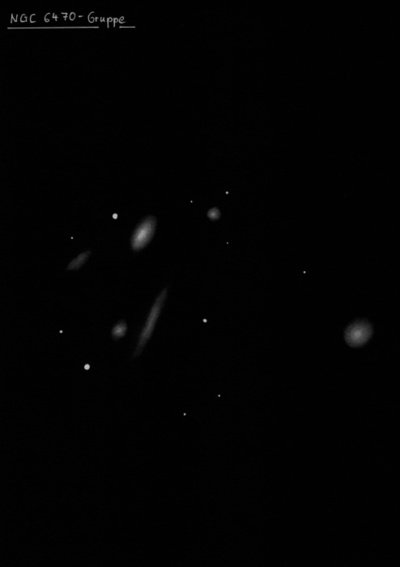
Lewis Swift discovered NGC 6470 = Sw. IV-56, along with NGC 6456, on 9 Jun 1886 and logged "eeeF; vS; R; ee dif; f of 2 [with NGC 6456]. His position is 4 tsec W and 0.4' south (41" southwest) of UGC 10974. Although several other galaxies are very nearby, including UGC 10973 just 1' south of his position, UGC 10974 is the brightest one and the mostly likely to have picked up by Swift. On 25 Sep he went through the cluster again and picked up several fainter galaxies, whose identities are not well determined.
RNGC, UGC, CGCG and MCG misidentify UGC 10973 as NGC 6470. See Harold Corwin's identification notes for NGC 6456.
400/500mm - 17.5" (6/11/88): very faint, very small, slightly elongated, small bright core. A mag 14 star is off the NE edge 0.7' from center. Member of the NGC 6456 group with NGC 6472 1.3' NW, NGC 6471 1.6' S, NGC 6477 1.5' SE and NGC 6463 4.0' W.
600/800mm - 24" (8/23/14): at 375x appeared faint, fairly small, slightly elongated N-S, 24"x18", small bright core. A mag 14 star is 0.7' NE. Brightest in a rich knot of galaxies with NGC 6471 = UGC 10973 1.6' SSW and NGC 6472 = PGC 2703230 1.3' NW and NGC 6477 = PGC 2702901 1.5' SE.
Notes by Steve Gottlieb
NGC 6670
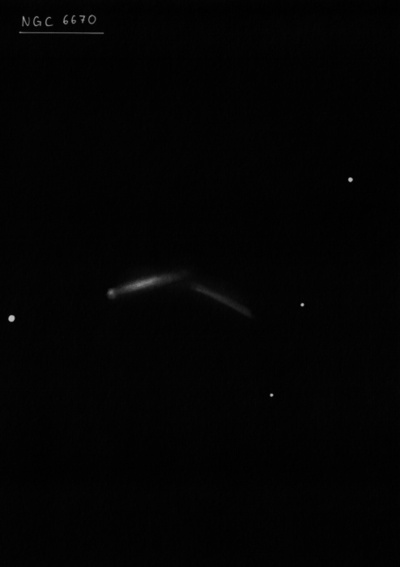
Lewis Swift discovered NGC 6670 = Sw. IV-71 on 31 Jul 1886 and recorded "eeF; S; cE; e diff.; between a F and a pB *, nearer the former." His position is fairly accurate and the "pB *" is mag 9 HD 238901, located 4.7' due west. Swift did not resolve this double system.
400/500mm - 17.5" (7/20/90): very faint, very small. With close inspection resolves into two galaxies oriented WSW-ENE (actually a triple system). The ENE member is larger and brighter and a mag 13 star is 30" SE of the ENE component. Forms a trio with CGCG 301-032 5' ESE.
600/800mm - 24" (7/21/12): the main two components of this interacting triple were easily resolved at 322x. The western component (NGC 6670B) appeared fairly faint, fairly small, very elongated WSW-ENE, 25"x8", even surface brightness. NGC 6670A is nearly in contact at the east end and appeared fairly faint, fairly small, elongated 2:1 WNW-ESE, 24"x12". The tiny companion at the eastern tip of NGC 6670A was not resolved. Located 4.5' E of mag 9 HD 238901.
Nearby is CGCG 030-032 5' SE, CGCG 030-030 9' W, and 2MFGC 14471 10' SSE. CGCG 030-032 appeared faint, very small, irregularly round, 15" diameter. CGCG 030-030 is fairly faint, small, round, 15"-18" diameter, slightly brighter nucleus. Located 4.6' WSW of mag 9.0 HD 238901. 2MFGC 14471 = LEDA 2597427 is extremely faint and small, 12" diameter. This low surface brightness edge-on is too faint to see any shape or structure. Situated between a mag 11.5 star 0.8' NNW and a mag 11 star 1.2' S.
900/1200mm - 48" (11/2/13): this fascinating interacting pair was observed at 488x and 813x. NGC 6670B, the western component, appeared as a moderately bright, very thin edge-on, 5:1 WSW-ESE, 0.6'x0.12'. NGC 6670A is the brighter eastern component and was slightly detached (perhaps by 12") from the western component. At 488x it appeared moderately bright with a high surface brightness, very elongated 3:1 WNW-ESE, 0.6'x0.2', contains a bright elongated core. An extremely small knot (LEDA 200359) is at the east-southeast tip. Using 813x, this knot (listed separately in the UGC notes, but probably a compact star forming region in NGC 6670A) was occasionally just cleanly detached, round, ~5" diameter, situated barely south of the major axis. A mag 12.5 star lies 1' ESE of the eastern component. Located 4.4' due E of mag 9.0 HD 238901. CGCG 301-32, 5' SE, appeared moderately bright, fairly small, elongated 3:2 SW-NE, 21"x14", brighter core.
Notes by Steve Gottlieb
UGC 10214
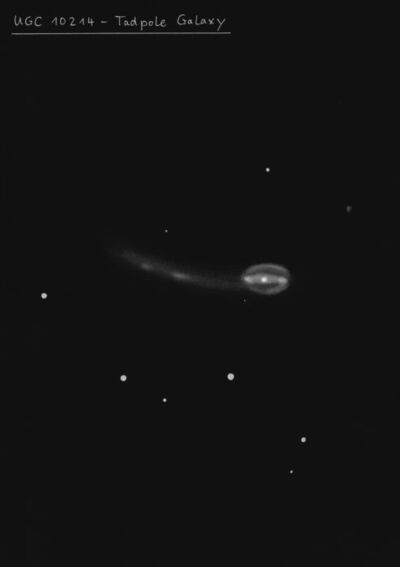
400/500mm - 17.5" (9/1/02): very faint, small, elongated ~E-W, 0.5'x0.3', low surface brightness. The previous month I mistook fainter MCG +09-26-052 located 12' NNW for this galaxy from the Sierra Buttes. In poorer conditions (haze from fires cut down transparency) I couldn't see MCG +09-26-052.
900/1200mm - 48" (5/15/12 and 4/21/17): at 488x, the "Tadpole Galaxy" appeared moderately to fairly bright, elongated 2:1 E-W, ~1.2'x0.7', contains a bright, elongated core (bar). The west end of the bar curves or bends slightly south (beginning of the southern spiral arm) and the east end curves slightly north (start of the northern spiral arm). The tidal plume, stretching 280,000 light years and captured spectacularly by the HST in 2002, was visible as a fairly thin, low surface brightness tail, extending east from the main body. It was faint, but clearly visible with averted vision angling east-northeast and doubling the overall length to ~2.3'. There seemed to be an extremely faint knot at the east tip. The portion of the plume further east was not visible. PGC 2502068 lies 2.1' WNW and MCG +09-26-054 is 4.2' SW.
Notes by Steve Gottlieb
IC 1259
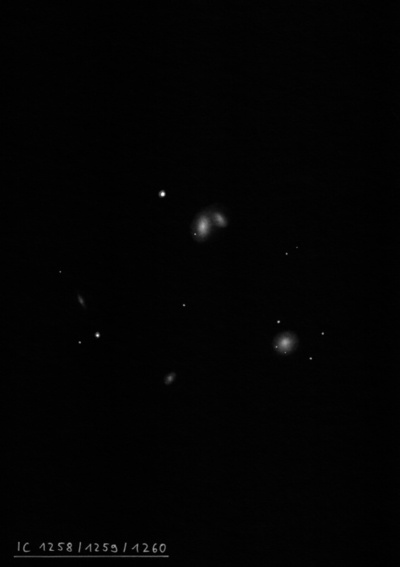
Lewis Swift discovered IC 1259 = Sw. VII-90, along with IC 1258, on 19 Jul 1887 and logged "pB; pS; R; nf of 2 [with IC 1258]." Swift didn't resolve this double system.
400/500mm - 18" (6/7/08): at 260x this double system (Arp 310) appeared faint, very small, ~20" diameter, quasi-stellar nucleus. VV 101b, an extremely small (~10" diameter) companion, was barely resolved off the west edge of the brighter eastern component (VV 101a). Also, a very faint mag 15 star is often visible at the SE edge. IC 1258 (part of Arp 311) is just 2.2' SW. Located 45" SW of a mag 12 star.
600/800mm - 24" (7/22/14): at 375x, the merged contact pair IC 1259 (15" between centers) was a striking sight. VV 101a, the larger and brighter eastern component, appeared fairly faint, small, round, 18" diameter. A mag 15 star is at the southeast edge, just 10" from center. VV 101b, the western component, appeared very faint, extremely small, 8" x 5" SW-NE. A mag 12 star lies 0.8' NE. IC 1258 lies 2.2' SW and IC 1260 is 2.5' SSE!
24" (8/15/12): fascinating tight double system and superimposed star at 375x. The main component appeared fairly faint, small, round, 20" diameter. VV 101b is attached at the west edge of the halo, 15" between centers. It appeared very faint, extremely small, 10" diameter. A mag 15 star is attached at the SE edge, just 10" from center! A mag 12 star lies 0.8' NE. IC 1258 lies 2.2' SW, IC 1260 is 2.5' SSE and PGC 2579433 is 2.5' SE. The group is located ~13' SE of mag 6.5 HD 158485.
Notes by Steve Gottlieb
NGC 4236_1
William Herschel discovered NGC 4236 = H V-51 = h1163 on 6 Apr 1793 (sweep 1036) and recorded "vF, mE, lbM, about 25' long, and losing itself imperceptibly, about 6 or 7' broad, from about 70° np to sf." His position, measured again on the next sweep, is accurate. John Herschel reported, "immensely large; vF; mE; vgbM; it fills more than a field, but is hardly distinguishable. Hazy." He incorrectly labeled his h1163 as H. V-17 in the Slough Catalogue.
300/350mm - 13.1" (5/27/84): faint, very large, very elongated NNW-SSE, weak concentration. In a field with five mag 8-9 stars.
400/500mm - 17.5" (3/29/89): faint, extremely large, edge-on 5:1 NNW-SSE. Appears as a ghostly streak about 20' length with only a broad, weak concentration! Best at low power due to size and low surface brightness.
Notes by Steve Gottlieb
UGC 10770
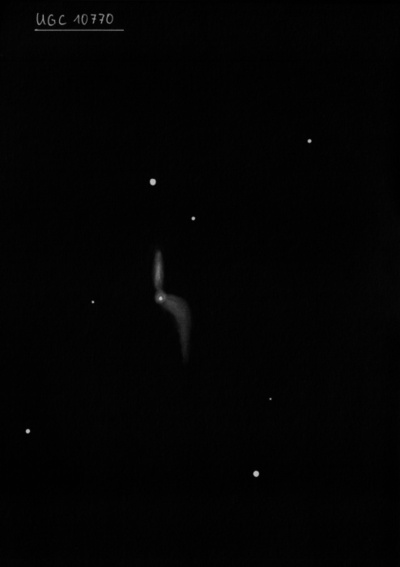
400/500mm - 18" (7/11/10): fairly faint, moderately large, elongated 5:2 N-S, 0.8'x0.3', even surface brightness. The extension on the NE end, which was not seen, may be a very faint companion. A mag 13 star lies 2.3' NNE. Classified by Arp as an "Integral Sign" system, though this may be an interacting pair.
900/1200mm - 48" (5/15/12): VV 89a, the brighter component of Arp 32, appeared moderately bright to fairly bright, moderately large, elongated 5:2 ~N-S, ~1.0'x0.25'. It was brighter at the north end and dimmed at the south tip. The galaxy has an unusual banana shape, slightly bending out towards the west! A very faint star (or stellar knot) is just east of the north end. VV 89b (the attached northern component) appeared fairly faint, small, slightly elongated N-S, ~20"x15".
Notes by Steve Gottlieb
UGC 5938
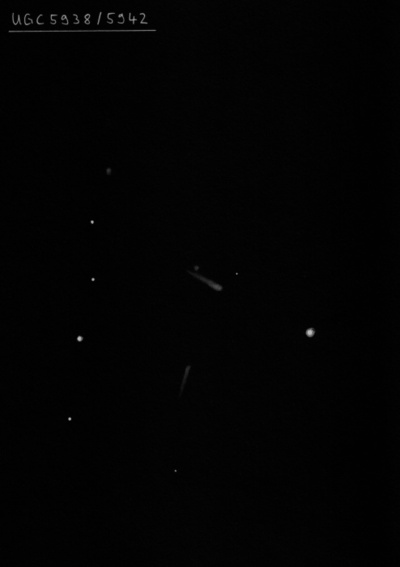
UGC 5938 forms a 1.2' pair to the south-southeast with superthin UGC 5942 (FGC 134A). Both of these galaxies have an unusually "cometary" shape with a brighter tip and and a thin tail that fades at the ends.
900/1200mm - 48" (4/16/15): faint, moderately large, fairly low surface brightness streak ~6:1 SW-NE, ~30"x5. Appears brighter at the southwest end. A mag 16 star lies 30" W. I also noted an extremely faint star at the northeast end, but on checking the SDSS it turns out this is a very compact galaxy (PGC 2774147 = 2MASX J10515293+7734355, V = 17.0).
Notes by Steve Gottlieb
HCG 80
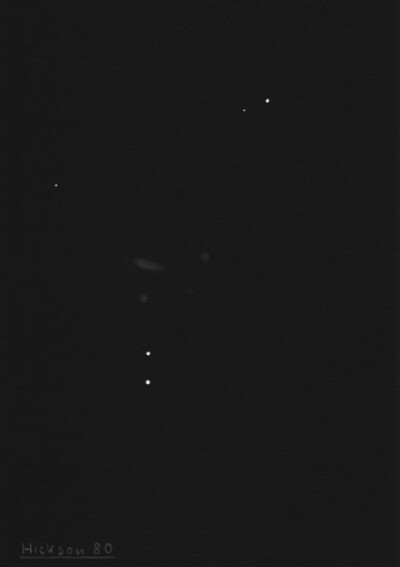
| Type | GALCL [E2] |
| RA | 15:59:12.3 |
| Dec | +65:13:33.0 |
| major_axis | 2.2' |
| mag | 12.6 |
| surface_bright | 99.9 |
HCG 78
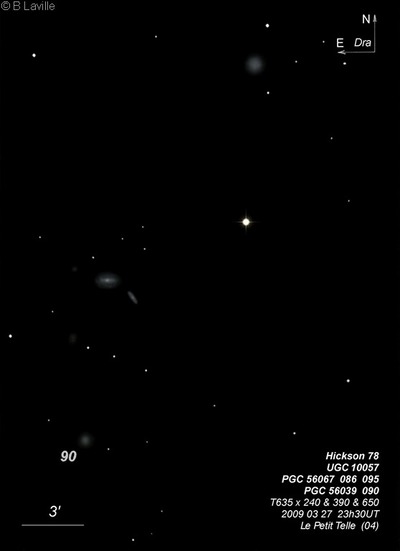
| Type | GALCL [S3] |
| RA | 15:48:28.0 |
| Dec | +68:12:28.0 |
| major_axis | 4.59' |
| mag | 12.7 |
| surface_bright | 99.9 |
HCG 85
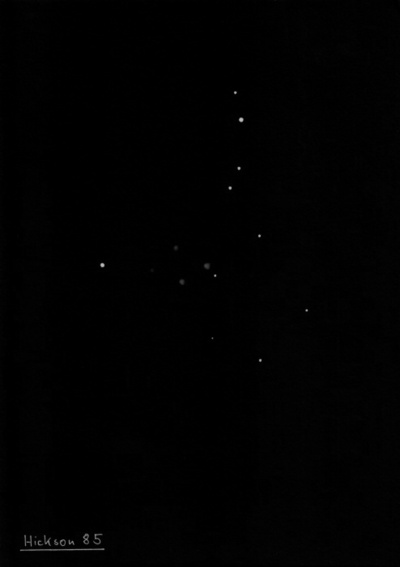
| Type | GALCL [E3] |
| RA | 18:50:22.3 |
| Dec | +73:21:00.0 |
| major_axis | 1.7' |
| mag | 12.8 |
| surface_bright | 99.9 |
NGC 6654A
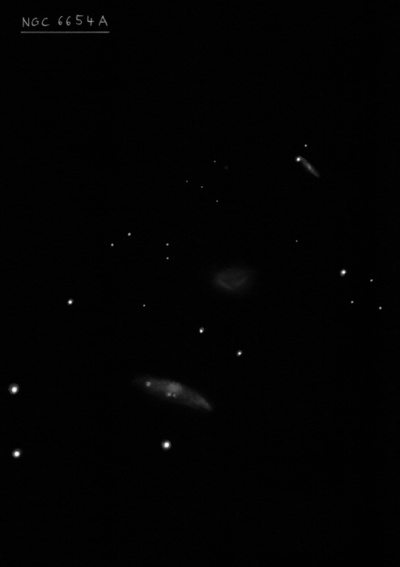
| Type | GX [SBd/P] |
| RA | 18:39:25.3 |
| Dec | +73:34:51.0 |
| major_axis | 2.7' |
| minor_axis | 48.0'' |
| position_angle | 63.0 |
| mag | 12.9 |
| surface_bright | 13.5 |
